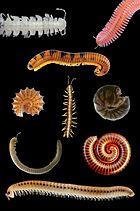节胸属
| 节胸属 | |
|---|---|

| |
| Arthropleura armata的化石(德国法兰克福森根堡自然博物馆) | |

| |
| Arthropleura armata的复原图 | |
| 科学分类 | |
| 界: | 动物界 Animalia |
| 门: | 节肢动物门 Arthropoda |
| 亚门: | 多足亚门 Myriapoda |
| 纲: | 倍足纲 Diplopoda |
| 目: | †节胸目 Arthropleurida |
| 科: | †节胸科 Arthropleuridae |
| 属: | †节胸属 Arthropleura |
| 种[1] | |
| |
| 异名 | |
| |
节胸属(学名:Arthropleura),又称节胸蜈蚣属,是史前的倍足纲节肢动物,即现今蜈蚣及马陆的远古亲属。虽然名叫节胸蜈蚣,但是实际上比起蜈蚣与马陆的亲缘关系较近。它们生存于3亿4500万至2亿9000万年前的石炭纪维宪期至二叠纪的萨克马尔期[1][2],分布在北美洲及苏格兰。它们已知陆地上最大型的无脊椎动物,相信只有少数的天敌。
分类学
[编辑]节胸目属于倍足纲节胸亚纲,为一目一科一属。亦有科学家将节肋目与Eoarthropleurida并入毛尾马陆亚纲之下,作为毛马陆目的姊妹群[3][4]。
特征及行为
[编辑]-
节胸属身体前端构造复原图
-
节胸属腿部构造复原图
-
现存马陆的头部构造
-
节胸属的最大体型个体复原图

节胸属的体型可长达2.5米(8英尺2英寸)[5],于新斯科细亚省的乔金斯则发现宽度达50厘米(1.6英尺)的痕迹化石[6]。于2021年所发现的节胸属蜕皮化石,宽度可达55厘米(22英寸),体长估计约为1.9至2.63米(6英尺3英寸至8英尺8英寸),体重可达50千克(110磅)[7][1]。
节胸属拥有30节体节,足的对数与体节的比例为 8:6 ,和部分现存的马陆相同。[8]
目前普遍认为所发现节胸属的化石均为它们蜕下来的壳而非尸骸[9]。它们最初被认为仅是生存于煤炭森林[10],然而在之后科学家在更开阔的地带也有发现足迹化石,甚至是在石炭纪雨林崩溃事件之后发现节胸属的化石,显示它们能生存于森林之外的生态系[1]。
虽然未有发现节胸属口部的化石,原先认为保存于标本肠道内的蕨类孢子与石松门植物残骸[11],后来证实可能只是恰好出现在蜕皮旁边的植物化石[8]。不过科学家仍然认为节胸属的成员普遍均为植食性,除了孢子外,可能也以果实、孢子叶及种子为食,以植物为食才有足够的营养让它们长大如此巨大的体型[9]。
在多个地方也有发现节胸属的化石化足印。这些化石是一排细小的平行足印,可见它们能快速的行走,穿越森林。当快速行走时,它们的身体会拉长,同时拉长了其步距,使行走得更快。节胸属行走时可以帮助传播花粉或孢子。它们也有可能在水中行走,到湖泊及河流脱壳。此时的它们却很易受到鱼类及两栖类的侵袭。相反,它们在陆地上只有少数的天敌。
节胸属是于石炭纪演化自像甲壳类的祖先,且可以成长至比现今节肢动物更大,部分原因是当时地球大气层的高含氧量及缺乏大型的陆生脊椎动物掠食者。[12]
一些属于希留利亚纪的化石足印有时会被认为是属于节胸属。
灭绝
[编辑]节胸属于二叠纪初期就灭绝,当时潮湿的气候干涸,破坏了雨林及造成沙漠化。因此,大气的含氧量也大幅下降。巨型的节肢动物都不能在此干涸及低氧的环境下生存[13]。然而,许多节胸属化石发现于石炭纪雨林崩溃事件后,且它们的生存环境并不仅局限于雨林中,近年来认为节胸属灭绝的主因可能来自于四足类的竞争与逐渐变得干燥的赤道地区[1][9]。
大众文化
[编辑]在BBC制作的《与巨兽同行》第2集中,与原水蝎螈发生冲突,最后被石柱穿透身体而亡。
在同样是BBC制作的《史前公园》第5集出现,主人翁奈吉尔·马文从石炭纪带回节胸属、巨脉蜻蜓与普莫诺蝎各一只。
在英国独立电视台制作的《重返侏罗纪》中第1季第2集出现,但体型被过分放大且被描述为带有剧毒的凶猛蜈蚣。
在沙盒动作冒险游戏《方舟:生存进化》中,玩家可以捕捉并骑乘节胸属,不过游戏中的节胸属为带有喷酸能力的虚构物种。
参考
[编辑]- ^ 1.0 1.1 1.2 1.3 1.4 Neil Davies; et al. The largest arthropod in Earth history: insights from newly discovered Arthropleura remains (Serpukhovian Stainmore Formation, Northumberland, England). Journal of the Geological Society. Dec 21, 2021 [2022-08-14]. S2CID 245401499. doi:10.1144/jgs2021-115. (原始内容存档于2021-12-23).
- ^ Ronald L. Martino and Stephen F. Greb (2009). "Walking Trails of the Giant Terrestrial Arthropod Arthropleura from the UpperCarboniferous of Kentucky" 互联网档案馆的存档,存档日期2019-12-23.. Journal of Paleontology. Retrieved on 23 December 2019.
- ^ Shear, William A.; Edgecombe, Gregory D. The geological record and phylogeny of the Myriapoda. Arthropod Structure & Development. 2010, 39 (2–3): 174–190. PMID 19944188. doi:10.1016/j.asd.2009.11.002.
- ^ Kraus, O; C. Brauckman. Fossil giants and surviving dwarfs. Arthropleurida and Pselaphognatha (Ateolocerata, Diplopoda): characters, phylogenetic relationships and construction. Verh. Naturwiss. Ver. Hamburg. 2003, 40 (5): 5–50.
- ^ George r. Mcghee, Jr. When the Invasion of Land Failed: The Legacy of the Devonian Extinctions. 2013-11-12. ISBN 9780231160575.
- ^ The Excitement of Discovery. Virtual Museum of Canada. [2006-04-17]. (原始内容存档于February 4, 2012).
- ^ Largest-ever millipede fossil found on Northumberland beach. BBC News. 21 December 2021 [21 December 2021]. (原始内容存档于2022-09-22).
- ^ 8.0 8.1 Sues, Hans-Dieter. Largest Land-Dwelling "Bug" of All Time. National Geographic. Ford Cochran. [14 February 2017]. (原始内容存档于2016-03-04).
- ^ 9.0 9.1 9.2 Schneider, Joerg; Lucas, Spencer; Werneburg, Ralf; Rößler, Ronny. Euramerican Late Pennsylvanian/Early Permian arthropleurid/tetrapod associations – implications for the habitat and paleobiology of the largest terrestrial arthropod. New Mexico Museum of Natural History and Science Bulletin. 2010-05-01, 49: 49–70.
- ^ Kraus, O.; Brauckmann, C. Fossil giants and surviving dwarfs. Arthropleurida and Pselaphognatha (Atelocerata, Diplopoda): characters, phylogenetic relationships and construction. Verhandlungen des Naturwissenschaftlichen Vereins in Hamburg. 2003-05-05, 40: 5–50 [2022-08-17]. (原始内容存档于2018-09-09) (英语).
- ^ A. C. Scott; W. G. Chaloner & S. Paterson. Evidence of pteridophyte–arthropod interactions in the fossil record (PDF). Proceedings of the Royal Society of Edinburgh. 1985, 86B: 133–140.[永久失效链接]
- ^ M. G. Lockley & Christian Meyer. The tradition of tracking dinosaurs in Europe. Dinosaur Tracks and Other Fossil Footprints of Europe. Columbia University Press. 2013: 25–52 [2018-06-12]. ISBN 9780231504607. (原始内容存档于2020-06-02).
- ^ Thom Holmes. The first land animals. March Onto Land: the Silurian Period to the Middle Triassic Epoch. The Prehistoric Earth. Infobase Publishing. 2008: 57–84. ISBN 9780816059591.
- 2006: The Complete Guide to Prehistoric Life. Pg. 37. Canada: Firefly Books Ltd.







